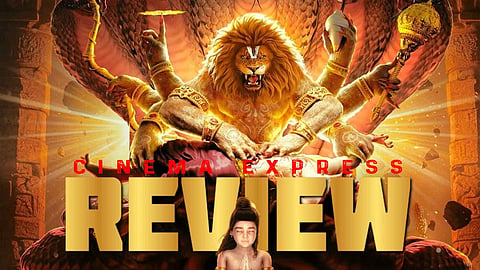Mahavatar Narasimha Movie Review: Unoriginal and unimaginative with nothing to root for
Mahavatar Narasimha Movie Review(1 / 5)
Mahavatar Narasimha Movie Review:
The memories of listening to stories from the Hindu pantheon always elicited wonder from deep imagination. Filled with metaphysical elements, the purpose of these stories was also to take the listeners back to a familiar space so that they get reminded as to why doing the right thing is the path to follow. Mahavatar Narasimha tells the story of Vishnu's two avatars, Varaha and Narasimha, and their conflicts with the demons Hiranyaksha and Hiranyakashipu. The film aims to return audiences to the earliest stages of post-independence Indian cinema, which was filled with stories from the Hindu pantheon, but falters in its path.
Being an animated film is the easiest way to add metaphysical elements that can spice up a story. The story behind Mahavatar Narasimha isn't devoid of such elements. Within the story, its main characters are human-animal hybrids created through magic. They fight demons, who threaten the safety of heaven, hell, and Earth—across all these realms. All of those involved in the conflicts are armed with weapons which are powerful enough to create a spectacle. While the animation works properly in its expression of colours and character outlines, it falters at some points. Be it Prahalad, Hiranyakashipu, or Vishnu himself, the audience is able to see that the characters' dialogues are rendered properly, but their expressions are not animated well enough. The design for the demons is starkly different from the humans, but this turns out to be a disadvantage, which makes these characters look robotic. The same goes for the character's movements, which disconnects the audience from the film.
Mahavatar Narasimha is a film that retells the oldest themes of good and evil. Through the story of Varaha and Hiranyaksha, it tries to convey the importance of conserving nature. Something that is relevant in today's world of pollution, global warming, and resource exploitation. But instead of exploring these themes properly, the film remains a devotion-only vehicle. The story of Prahalad's unwavering compromise to change his views in the face of extreme resistance and even death is also a story that appears repeatedly throughout history. But then again, the film stops from exploring this resistive nature of humans and instead stops at devotion. Retelling age-old stories that also explore themes of the current day and age helps the audience to root for characters, but since the film tries to stick to the source material, it refuses to venture into exploring these themes.
Thematic exploration apart, the film also suffers from the way it is structured. Mahavatar Narasimha is a misnomer, as the story isn't focusing on the Avatar but rather on everything else. Apart from the source materials, the film also retains the structure of the films from the 50s and 60s. The dialogues, the music, and the setup of a particular scene thrust its message down the throats of the audience, rather than the audience learning from it. For example, when Prahalad is to be killed by Holika, Hiranyakashipu looks on with satisfaction and laughs maniacally, still thinking that this would work. In the end, when Prahalad survives, the music hints at surprise and wonder, forgetting that the audience already knows how the story will turn out.
Mahavatar Narasimha also suffers from certain ideological disconnects. In the beginning, Diti seduces Kashyapa as he is in the midst of his daily rituals. But he consents to be with Diti, who in the end gets pregnant. Surprisingly, Kashyapa curses Diti for the ill fate that will fall upon them, for a situation where both of them have equal responsibilities. Scenes like these send out misogynistic messages to the viewers, adding to all the faults in the technical and writing aspects. Ultimately, what set out to be a film that wanted to express good morals turns out to be one bereft of these.


